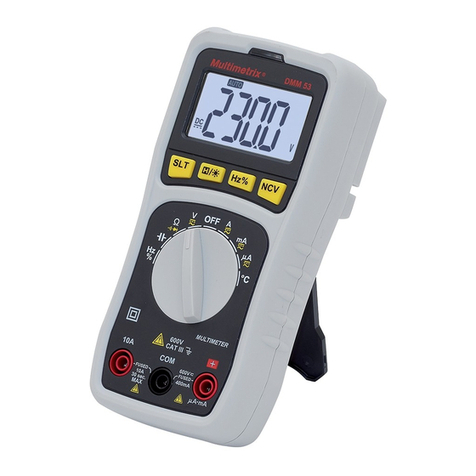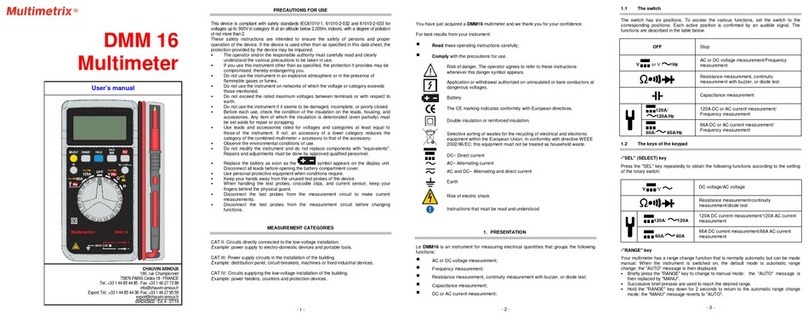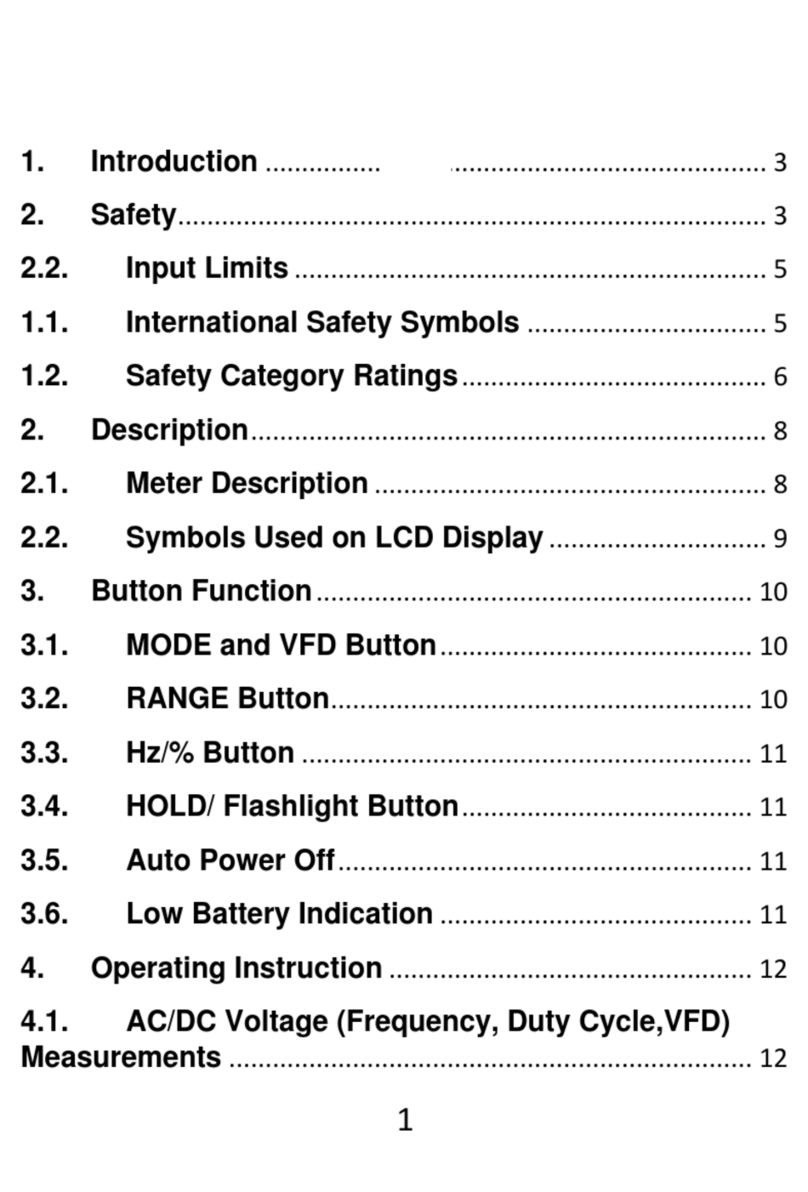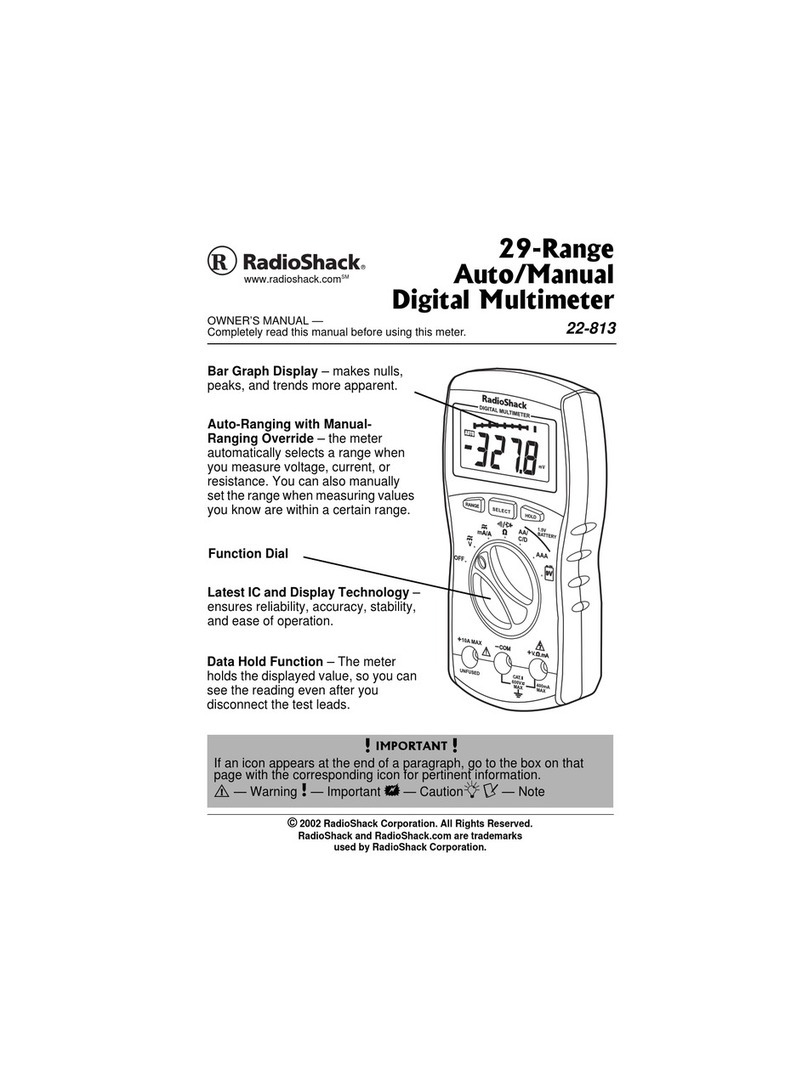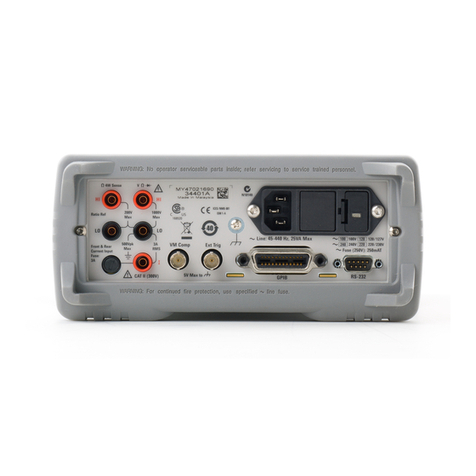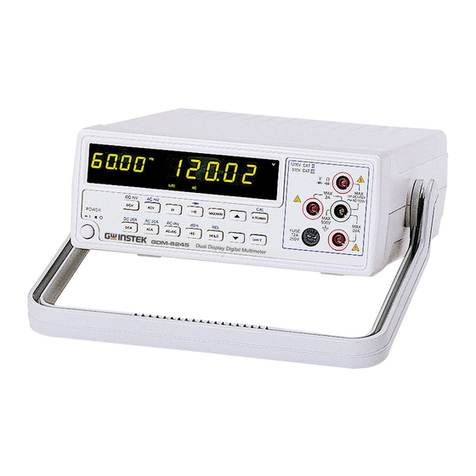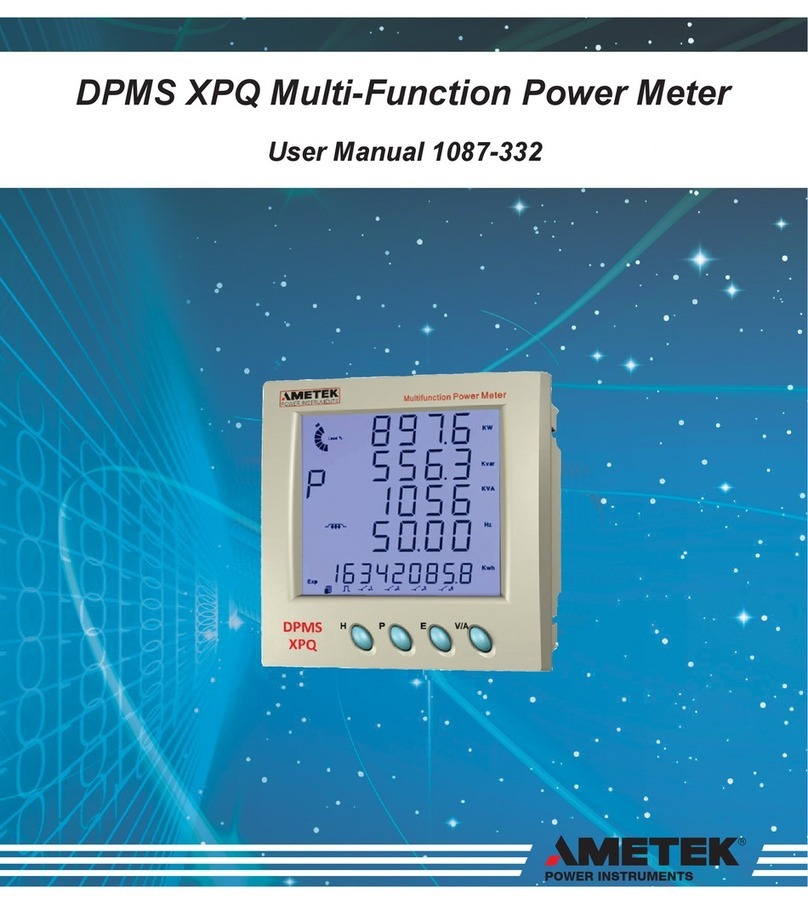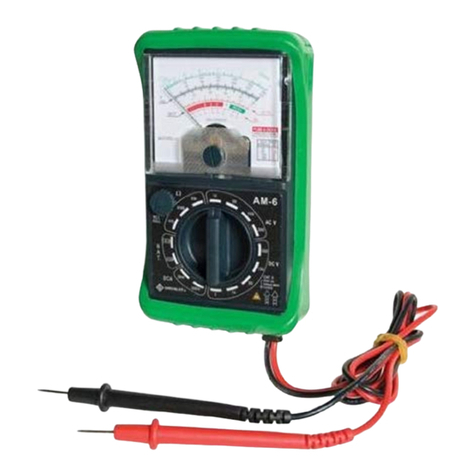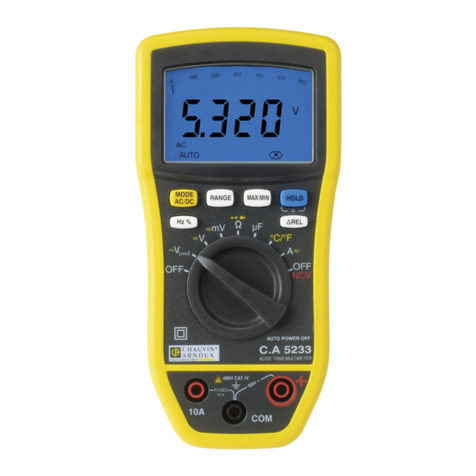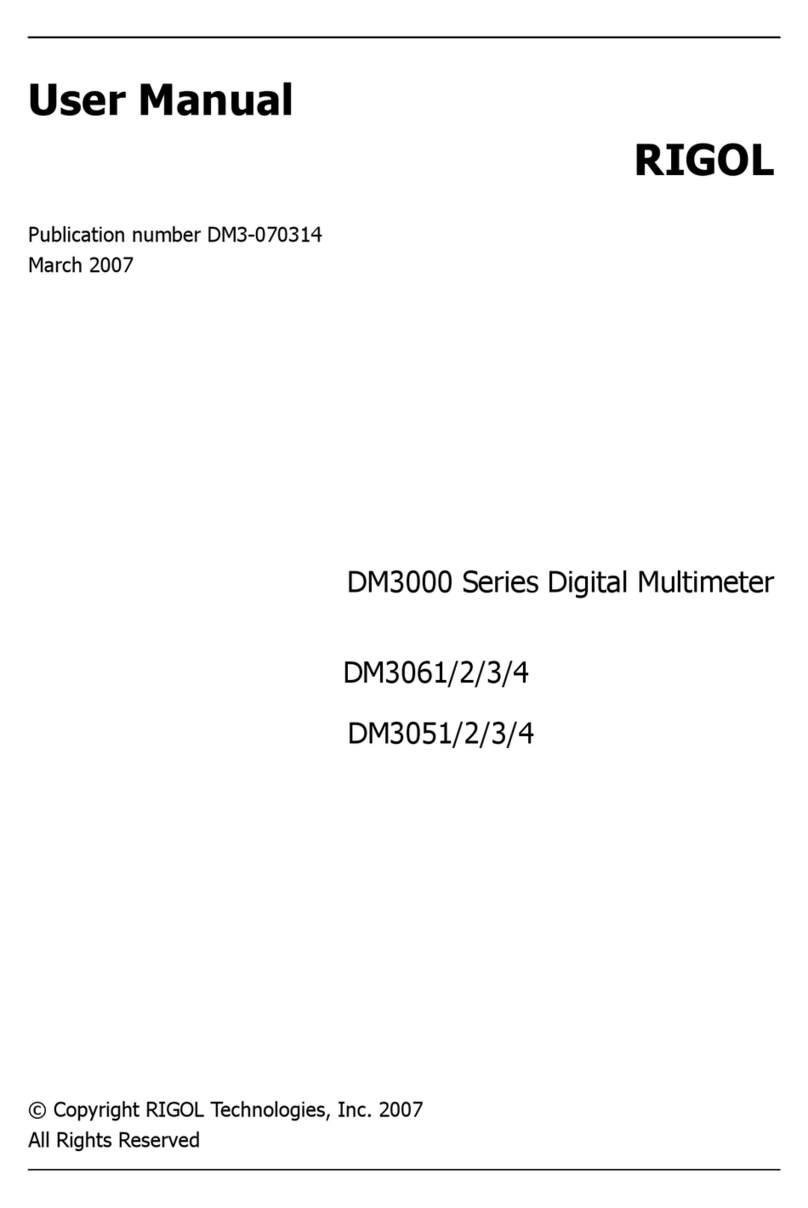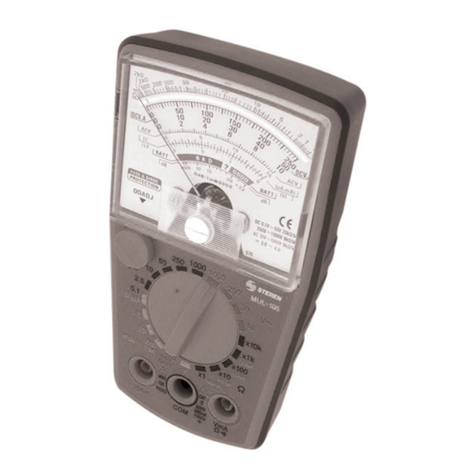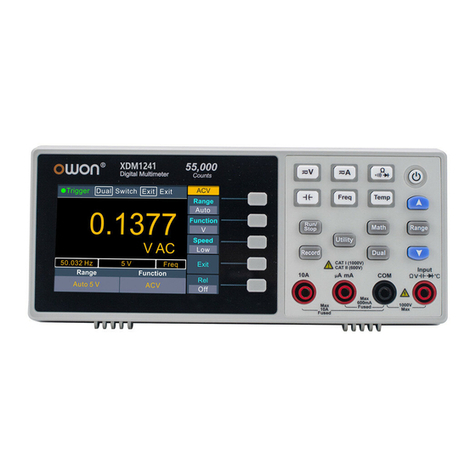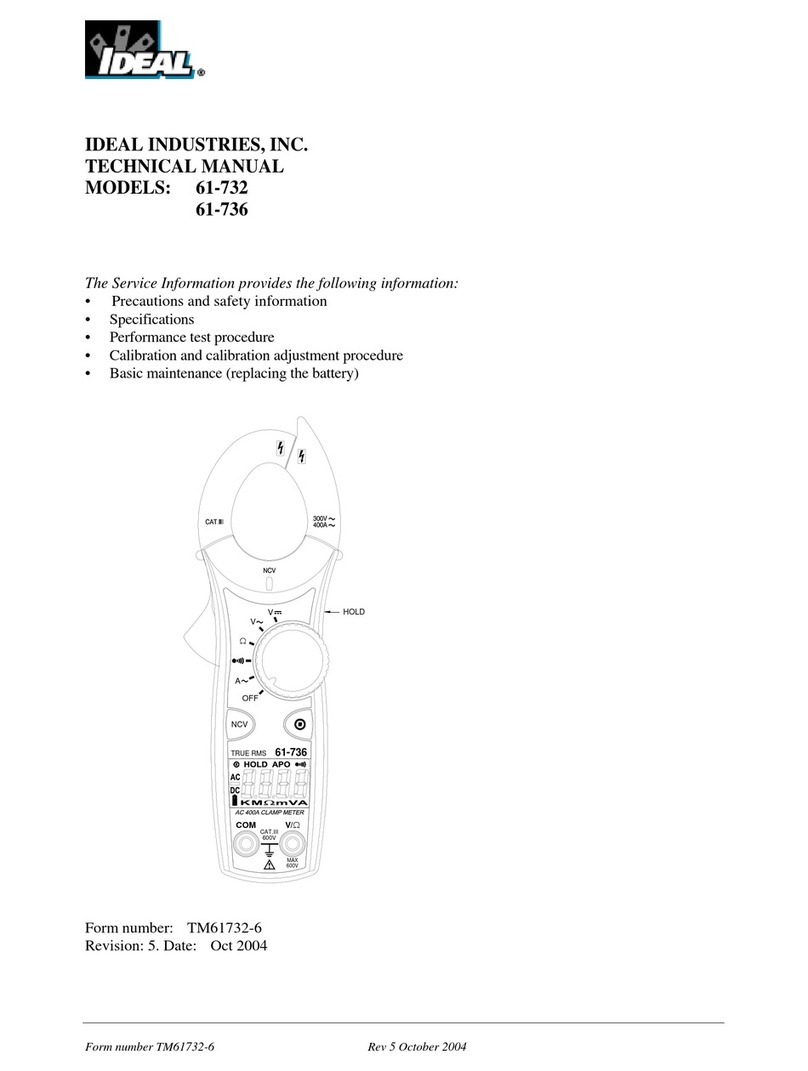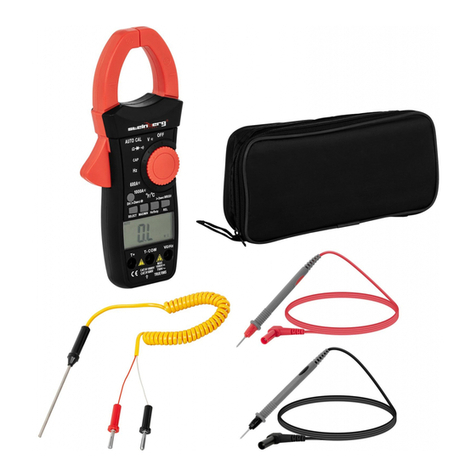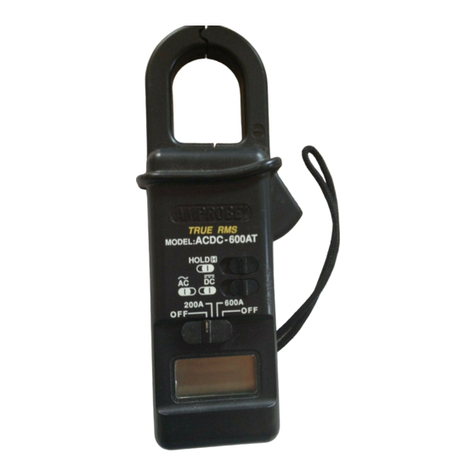Multimetrix CM 605 User manual

1
691178A00
691188A00
ed2

Français .............................................................................................3
English ...............................................................................................9
Deutsch............................................................................................15
Italiano..............................................................................................22
Español ............................................................................................28
2

CONDITIONS GENERALES
DE GARANTIE ET DE SECURITE
1. PRECAUTIONS D’EMPLOI
Lisez les instructions de sécurité ci-dessous avant toute utilisation de
l’appareil, afin d’éviter les accidents corporels, tels que brûlures et
chocs électriques.
Suivez impérativement les indications précédées du symbole
1.1 DEFINITION DES CATEGORIES D’INSTALLATION (CF. CEI 664-1)
CAT I : Circuits protégés par des dispositifs limitant les surtensions
transitoires à un faible niveau. Exemple : circuits électroniques
protégés.
CAT II : Circuits d'alimentation d'appareils domestiques ou analogues,
pouvant comporter des surtensions transitoires de valeur moyenne.
Exemple : alimentation d'appareils ménagers et d'outillage portable.
CAT III : Circuits d'alimentation d'appareils de puissance pouvant
comporter des surtensions transitoires importantes. Exemple :
alimentation de machines ou appareils industriels
1.2 NORME
Se référer aux normes et catégories d’installation mentionnées dans la
notice spécifique de chaque appareil.
Attention, cet appareil n’est pas un Vérificateur d’Absence de tension
ou un détecteur de Tension au sens de l’UTE C18510.
1.3 EXPLICATIF DES SYMBOLES
Symbole Signification Symbole Signification
Instrument à double
isolation.
Fusible.
Courant alternatif.
Homologation CE.
Courant continu.
Conformément à la
directive WEEE
2002/96/EC
Attention. Se référer
aux instructions
d’utilisation.
Terre.
Ne pas appliquer ou
enlever sur des
conducteurs sous
tension dangereuse.
1.4 POUR TRAVAILLER EN SECURITE
Ce pictogramme est applicable à tout le paragraphe.
Soyez particulièrement vigilants pour des tensions supérieures à 30
VAC RMS et 50 VDC.
Ne travaillez jamais au-delà des plages de tension maximales
indiquées notamment par rapport à la terre.
Lors de la mesure d’intensité, vérifiez toujours que la valeur du courant
à mesurer est compatible avec le calibre de l’appareil. Pour les
appareils équipés de fusibles, contrôler leur état avant toute mesure.
Ne remplacer les fusibles usagés que par ceux recommandés dans la
notice particulière au produit.
N’utilisez pas l’appareil dans un environnement humide et/ou
poussiéreux.
N’utilisez jamais l’appareil sans gants pour électriciens et autres
équipements de sécurité préconisés par la législation.
Les doigts ne doivent jamais dépasser la garde de la pointe de touche.
Ne jamais mettre les doigts en contact avec la partie métallique de la
pointe de touche.
Vérifiez la qualité mécanique et électrique des cordons et des pointes
de touche avant toute mesure. Les pointes de touche ou cordons
endommagés devront être immédiatement changés. N’utilisez pas
l’appareil en cas de détérioration
Ne travaillez jamais avec le boîtier arrière de l’instrument ouvert.
Ne changez pas les piles lorsque les cordons sont connectés.
N’utilisez pas ou n’exposez pas l’instrument au soleil, à des
températures ou un taux d’humidité élevée.
Ne modifiez jamais le circuit électronique interne.
Ne démontez pas le boîtier ; seule la trappe à piles peut être ouverte.
3

1.5 RECOMMANDATIONS DIVERSES DE SECURITE
Pour les appareils des catégories d’installation I et II, ne travaillez
jamais sur des équipements pouvant générer des pics de tension
(moteurs, etc.).
Pour la mesure en gamme manuelle, commencez toujours par la
gamme maximale. Sélectionnez ensuite la gamme la plus
appropriée.
Connectez en premier la pointe de touche noire, puis la rouge.
Déconnectez les cordons préalablement au changement de
fonction.
Déconnectez en premier la pointe de touche rouge, puis la noire.
Utilisez et installez les piles conformément aux instructions de la
notice spécifique au produit acheté.
Vérifiez l’absence de tension avant l’utilisation des fonctions
ou Ω.
2. GARANTIE
Ce matériel est garanti contre tout défaut de matière ou vice de
fabrication, conformément aux conditions générales de vente. Durant la
période de garantie, l'appareil ne peut être réparé que par le constructeur,
celui-ci se réservant la décision de procéder soit à la réparation, soit à
l'échange de tout ou partie de l'appareil. En cas de retour du matériel au
constructeur, le transport aller est à la charge du client. La garantie ne
s’applique pas suite à :
Une utilisation impropre du matériel ou par association de celui-ci
avec un équipement incompatible.
Une modification du matériel sans autorisation explicite des
services techniques du constructeur.
L’intervention effectuée par une personne non agréée par le
constructeur.
L’adaptation à une application particulière, non prévue par la
définition du matériel ou par la notice de fonctionnement.
Un choc, une chute ou une inondation.
Renseignements et coordonnées de nos services après-vente :
En France Métropolitaine, sur demande au (0)2.31.64.51.55,
télécopie : (0)2.31.64.51.09.
Ou auprès de votre Distributeur.
3. DEBALLAGE ET RE-EMBALLAGE
L’ensemble du matériel a été vérifié mécaniquement et électriquement
avant l’expédition.
Toutefois, il est conseillé de procéder à une vérification rapide pour
détecter toute détérioration éventuelle lors du transport. Si tel était le cas,
faites alors immédiatement les réserves d’usage auprès du transporteur.
En cas de réexpédition, utilisez l’emballage d’origine et indiquez, par une
note jointe à l’appareil, les motifs du renvoi.
4. MAINTENANCE
4.1 VERIFICATION METROLOGIQUE
Comme tous les appareils de mesure ou d'essais, une vérification
périodique est nécessaire. Renseignements et coordonnées sur
demande : tél. (0) 2.31.64.51.55 - fax (0)2.31.64.51.09 ou auprès de votre
distributeur.
4.2 ENTRETIEN
Périodiquement, nettoyez votre multimètre avec un tissu humide imprégné
d'eau savonneuse. Ne pas utiliser de matières abrasives ou contenant des
solvants.
4.3 REPARATION HORS DE FRANCE METROPOLITAINE.
Pour toute intervention sous garantie ou hors garantie, l’appareil sera
retourné au distributeur.
5. STOCKAGE
Retirez la ou les piles et stockez-les séparément si votre appareil de
mesure n’est pas utilisé pendant une période supérieure à 60 jours.
4

UTILISATION
6. PRESENTATION
6.1 LA FACE AVANT
Rep. Fonction
1. Borne négative noire (-) COM.
2. Afficheur à cristaux liquides: 4 digits (9999 points).
‘OL’ : dépassement de capacité en mesure de courant et
tension.
3. Gâchette d’ouverture de la pince.
4. Garde : la main doit toujours se trouver à l’arrière de cette
protection durant la mesure.
5. Mâchoire mobile.
6. Mâchoire fixe et entrefer. Le conducteur doit être localisé
au centre de cette zone durant la mesure pour une
précision maximale.
7. Touches HOLD et PEAK.
HOLD : fige la mesure (Data Hold) ; l’icone est
affichée lorsque la fonction est activée. Un nouvel appui
annule la fonction.
PEAK : affiche la valeur crête ; l’icone est affichée
lorsque la fonction est activée pour les fonctions
. Pour désactiver la fonction, appuyer sur
HOLD pendant 2 secondes.
8. Sélecteur rotatif de fonction.
OFF : multimètre hors-tension.
: mesure des courants alternatifs (100 A)
: mesure des courants continus (100 A).
: mesure des tensions alternatives (600 V).
: mesure des tensions continues (600 V).
: mesure de résistance et de continuité (10 kΩ).
9. Touche ZERO. La mesure est considérée comme le zéro
dès appui ; l’icone est affichée. Annulation par un
nouvel appui.
10. Borne positive rouge (+).
6.2 L’AFFICHEUR
Rep. Fonction Rep. Fonction
11. Valeur négative. 18. Maintien valeur.
12. Arrêt automatique. 19. Test de continuité.
13. Piles faibles. 20. Mesure de courant.
14. Mesure
alternative/continue.
21. Mesure de tension.
15. Gammes automatiques. 22. Mesure de résistance.
16. Mesure relative. 23. Lecture de mesure.
17. Valeur maximale crête.
7. UTILISATION
7.1 MISE EN SERVICE DU MULTIMETRE
Positionner le sélecteur (rep. 8) sur une position autre que OFF.
7.2 ARRET DU MULTIMETRE
Arrêt manuel
Positionner le sélecteur (rep. 8) sur OFF.
Arrêt automatique
Le multimètre s’éteint automatiquement 30 minutes après la dernière
mesure.
Annuler l’arrêt automatique
1. Positionner le sélecteur (rep. 8) sur OFF.
2. Maintenir la touche ZERO (rep. 9) appuyée et tourner le
sélecteur (rep. 8) sur une position autre que OFF.
L’icone
s’efface ; l’arrêt automatique est désactivé.
Valider l’arrêt automatique
1. Positionner le sélecteur (rep. 8) sur OFF.
2. Positionner le sélecteur sur une position autre que OFF.
L’icone s’affiche ; l’arrêt automatique est activé.
5

7.3 MESURE DE TENSION
Lisez les recommandations de sécurité avant utilisation.
Gammes de mesure automatiques 600 V DC ou AC.
1. Positionner le sélecteur (rep. 8) sur :
- pour mesurer une tension continue.
- pour mesurer une tension alternative.
2. Insérer le connecteur noir dans la borne COM (rep. 1), le rouge
dans la borne + (rep. 10) et lire la valeur de la tension une fois
celle-ci stabilisée.
Lorsque l’icone AUTO (rep. 23) est affichée, le multimètre détermine
la gamme de mesure optimale.
Pour une tension continue, l’icone « -» (rep. 11) indique une
inversion de polarité des touches.
L’affichage de « OL » indique un dépassement de capacité.
Pour afficher la valeur crête maximale (PEAK), voir § 7.9.
Pour maintenir la valeur lue (DATA HOLD), voir § 7.10.
3. Positionner le sélecteur sur OFF.
7.4 MESURE DE COURANT CONTINU
Lisez les recommandations de sécurité avant utilisation.
Gammes de mesure automatiques de 10 ADC à 100 ADC (3 gammes).
1. Positionner le commutateur (rep. 8) sur .
2. Appuyer sur la touche ZERO (rep. 9) pour régler le zéro.
L’icone
est affichée ; la valeur est mémorisée comme valeur de
référence pour les mesures suivantes. Appuyer de nouveau sur la
touche ZERO (rep. 9) pour quitter le mode zéro.
3. Appuyer sur la poignée (rep. 3) pour ouvrir la pince (rep. 5) et
placer un conducteur au centre de la pince (Fig. 3).
Nota : ne jamais insérer les deux conducteurs +et –d’un même
circuit dans la pince ; la lecture serait nulle.
4. Lire la valeur du courant une fois celle-ci stabilisée.
Avec l’icone AUTO (rep. 15) affichée, le multimètre détermine la
gamme de mesure optimale.
L’icone « -» (rep. 11) indique une inversion de polarité ; se référer au
repère « +» gravé sur la pince (rep. 6).
L’affichage de « OL » indique un dépassement de capacité.
Pour afficher la valeur crête maximale (PEAK), voir § 7.9.
Pour maintenir la valeur lue (DATA HOLD), voir § 7.10.
5. Ouvrir la pince, libérer le conducteur et positionner le sélecteur
sur OFF.
7.5 MESURE DE COURANT ALTERNATIF
Gammes de mesure automatiques de 10 AAC à 100 AAC (3 gammes).
1. Positionner le sélecteur (rep. 8) sur .
2. Appuyer sur la poignée (rep. 3) pour ouvrir la pince (rep. 6) et
placer un conducteur au centre (Fig. 3).
Nota : ne jamais placer les deux conducteurs d’un même circuit dans
la pince ; la lecture serait nulle.
3. Lire la valeur du courant une fois celle-ci stabilisée.
L’icone AUTO (rep. 15) est affichée ; le multimètre détermine la
gamme de mesure optimale.
L’affichage de « OL » indique un dépassement de capacité.
Pour afficher la valeur crête maximale (PEAK), voir § 7.9.
Pour maintenir la valeur lue (DATA HOLD), voir § 7.10.
4. Ouvrir la pince, libérer le conducteur et positionner le sélecteur
sur OFF.
7.6 MESURE DE RESISTANCE
Lisez les recommandations de sécurité avant utilisation. Le
circuit sera impérativement hors-tension.
Gammes de mesure automatiques de 0 à 10 KΩ(1 gamme).
1. Positionner le sélecteur (rep. 8) sur .
2. Insérer le cordon noir dans la borne COM (rep. 1) et le cordon
rouge dans la borne + (rep. 10) et lire la valeur.
L’affichage de OL indique un dépassement de capacité.
Avec l’icone AUTO (rep. 23) affichée, le multimètre détermine la
gamme de mesure optimale.
3. Positionner le sélecteur sur OFF.
6

7.7 TEST DE CONTINUITE
Lisez les recommandations de sécurité avant utilisation. Le
circuit sera impérativement hors-tension.
1. Positionner le sélecteur (rep. 8) sur .
2. Insérer le cordon noir dans la borne COM (rep. 1), le rouge dans
la borne + (rep. 10) et appliquer les pointes de touche sur le
circuit à contrôler.
Le signal sonore sera audible lorsque le circuit à contrôler est continu
ou de résistance inférieure à 100 Ω± 20 Ω.
3. Positionner le sélecteur sur OFF.
7.8 SORTIE SIGNAL ANALOGIQUE
Lisez les recommandations de sécurité avant utilisation.
1. Positionner le sélecteur (rep. 8) sur ou .
2. Insérer un cordon dans la borne COM (rep. 1), un autre dans la
borne + (rep. 10). Appliquer les extrémités des 2 cordons à un
oscilloscope ou à un autre multimètre.
3. Appuyer sur la poignée (rep. 3) pour ouvrir la pince (rep. 5) et
placer un conducteur au centre (Fig. 3).
4. Une fois la pince refermée, lire le signal analogique sur
l’oscilloscope ou le multimètre.
Si le signal mesuré est continu, le signal de sortie sera continu. Si le
signal mesuré est alternatif, le signal de sortie sera alternatif.
5. Ouvrir la pince, libérer le conducteur et positionner le sélecteur
sur OFF.
7.9 AFFICHAGE DE LA VALEUR CRETE MAXIMALE (PEAK)
1. Positionner le sélecteur sur l’une des positions
et appuyer sur la touche HOLD (rep. 7) durant la mesure jusqu’à
ce que l’icone (rep. 17) s’affiche.
2. Effectuer la mesure.
La mesure maximale sera affichée et automatiquement mise à jour.
3. Pour désactiver la fonction, appuyer sur HOLD (rep. 7) pendant
2 s.
7.10 MAINTIEN DE LA VALEUR LUE (DATA HOLD)
1. Positionner le sélecteur sur l’une des
positions et appuyer sur HOLD (rep. 7) pendant
2 secondes.
L’icone
est affichée (rep. 18).
2. Effectuer la mesure.
La mesure est maintenue.
3. Pour désactiver la fonction, appuyer sur la touche HOLD (rep. 7)
pendant 2 secondes.
L’icone
est effacée (rep. 18).
7.11 MESURE RELATIVE
1. Appuyer sur la touche ZERO (rep. 9) pour activer le mode
zéro.
L’icone
est affichée ; la valeur est mémorisée comme valeur de
référence pour les mesures suivantes. Appuyer de nouveau sur la
touche ZERO (rep. 9) pour quitter le mode zéro.
8. REMPLACEMENT DES PILES
Lisez les recommandations de sécurité avant utilisation.
Le circuit sera impérativement hors-tension.
Remplacer les deux piles AAA lorsque l’icone est affichée (rep. 13) :
1. Déconnecter les pointes de touche.
2. Positionner le commutateur sur OFF.
3. Retirer la vis de fixation et le couvercle de logement de piles,
changer les 2 piles 1,5 V type AAA, en respectant les polarités.
4. Remonter en sens inverse (couvercle de logement de piles et
vis).
Nota : retirer les piles en cas d’inutilisation prolongée du multimètre.
7

9. CARACTERISTIQUES
9.1 GENERALES
Mesure des valeurs Tensions continues, tensions
alternatives, courant continu, courant
alternatif, résistance, test de continuité.
Afficheur 4 digits (9 999 points)
Polarité Indication signe « - ».
Gammes Sélection automatique.
Fonctions
additionnelles
sélectionnables
Arrêt automatique (ON ou OFF).
Affichage de dépassement de capacité
(OL).
Mesure crête maximale (Peak).
Maintien de la mesure (Data Hold).
Mode zéro, mesures relatives.
Usure piles Symbole pile faible .
Fréquence
d’échantillonnage
Environ 2 fois par seconde
Sortie analogique Sur gammes ACA et DCA
10 mV/A (20 kHz ±3 dB).
Précision : ±4.5% de lecture +0.5 mV
Impédance de sortie : environ 3 kΩ.
Protection de surcharge : 600 V RMS
Conditions
d’utilisation
0 à 40°C (32 °F - 122 °F). RH < 80 %,
absence de condensation.
Conditions de
stockage
-10°C à 60°C (14 – 140 °F); RH < 70 %,
absence de condensation et batterie
retirée.
Alimentation
électrique
2 piles 1,5 V type AAA.
Autonomie (en
mesure VDC)
45 heures avec pile alkaline.
Dimensions et
masse
202 x 70 x 34 mm / 7.95 x 2.76 x 1.33
inch. (L x l x H). 180 g (avec batteries)
Degré de pollution 2
CEI CEI 61010, 600 V, CAT II.
Livrés avec
l’instrument
2 piles 1,5 V type AAA.
Deux cordons à pointe de touche
Une notice de fonctionnement.
Une sacoche de transport.
9.2 TECHNIQUES
Conditions de références : 18°C - 28°C ; RH < 80 %, absence de
condensation. Norme : NF EN 61010-1, 600V CAT II, 300 V, CAT III.
Les précisions sont données de 5% à 100% de chaque gamme.
Voir tableau en page 34.
8

GENERAL SAFETY
AND GUARANTEE CONDITIONS
1. PRECAUTIONS DURING USE
Please read the safety instructions below before using the instrument to
avoid any accidental injuries, such as burns or electric shocks.
You must observe the instructions preceded by the symbol .
1.1 DEFINITION OF THE INSTALLATION CATEGORIES
(Cf. CEI 664-1)
CAT I: Circuits protected by devices restricting temporary excessive
voltages to a low level. E.g.: protected electronic circuits.
CAT II: Power circuits for domestic appliances or similar equipment,
which may be subject to medium level temporary excessive voltages.
E.g.: power supplies for domestic appliances and portable power tools.
CAT III: Power circuits for powerful machinery, which may be subject to
significant temporary excessive voltages. E.g.: power supplies for
industrial machinery and equipment.
1.2 NORMS
Please refer to the norms and installation categories mentioned in the
specific instructions for each unit.
Warning! This instrument is not a voltage or non-voltage detector in the
sense of UTE C18510.
1.3 EXPLANATION OF THE SYMBOLS
Symbol Signification Symbol Signification
Instrument with
double insulation.
Fuse.
Alternating current
(AC).
CE approved.
Direct current (DC).
According to WEEE
directive
2002/96/EC
Warning! Please refer
to the operating
instructions.
Do not apply around
or remove from
hazardous live
conductors
Earth.
1.4 FOR WORKING SAFELY
This symbol applies to the whole of this section.
Take particular care with voltages in excess of 30V AC RMS and 50V
DC.
Never work above the indicated maximum voltage ranges, particularly
with regards to the Earth.
When measuring the intensity, always check that the value for the
current to be measured is within the measurement range of the
instrument. For instruments fitted with fuses, check the fuses’ condition
before taking any measurements. Only replace worn-out fuses with the
fuses recommended in the product’s instruction manual.
Never use the instrument in a damp or dusty environment.
Never use the instrument without wearing electrician’s gloves and the
other safety equipment recommended by the legislation.
Never touch any metal part of the contact points with your finger.
Check the mechanical and electrical condition of the test leads and the
contact points before taking any measurements. Any test leads or
contact points that are damaged must be replaced immediately. Never
use the instrument if it is damaged.
Never work with the instrument’s rear casing open.
Never change the batteries while the power cables are connected.
Do not use the instrument in, or expose it to, direct sunlight, high
temperatures or high levels of humidity.
Do not remove the casing; only the battery compartment cover may be
opened.
Never alter the internal electronic circuits.
9

1.5 OTHER SAFETY RECOMMENDATIONS
For instruments of installation categories I and II, never work on
equipment that could generate voltage spikes (motors, etc.).
When measuring in the manual range, always start with the
maximum range and then select the most appropriate range.
First of all connect the black contact point and then the red one.
Disconnect the test leads before changing function.
First of all disconnect the red contact point and then the black one.
Use and install batteries that comply with the instructions in the
user’s manual for the product you have purchased.
Check that there is no voltage present before using the and Ω
functions.
To measure voltage, to measure current:
Please read the safety recommendations before use.
To measure resistance, diode test, Continuity test, to measure
frequency / cycle ratio, to replace batteries and fuse.
To measure capacity there must be no voltage in the circuit and the
capacitor to be measured must be discharged.
2. GUARANTEE
The instrument is guaranteed against any material or manufacturing fault
in accordance with the General Sales Conditions. During the guarantee
period, the instrument may only be repaired by the manufacturer, who
reserves the right either to proceed to repair the product or replace it in
whole or in part. If any equipment is returned to the manufacturer, the
customer is responsible for paying the outward transport costs. The
guarantee does not apply in the case of:
Improper use of the instrument or its use with incompatible
equipment.
Modification of the instrument without express authorisation from
the manufacturer’s technical departments.
Any work being performed on the instrument by anyone not formally
approved by the manufacturer.
Any adaptation for any particular application not provided for in the
instrument’s definition or the operating instructions.
An impact, a fall or drenching in water.
Information and contact details for our After-Sales Services: contact
your distributor.
3. UNPACKING AND REPACKING
All the equipment has been checked mechanically and electrically before
dispatch. However, you are advised quickly to check for any damage
during transport. Should this be the case, inform the freight forwarder
immediately of your reservations. If you are sending anything back, please
use the original packaging and attach a note indicating the reason for the
return.
4. MAINTENANCE
4.1 METROLOGICAL CHECKS
As with any measuring or testing instrument, periodic checking is required.
Information and contact details are available on request: Telephone (+33)
2.31.64.51.55 - Fax (+33) 2.31.64.51.09 or contact your distributor.
4.2 SERVICING
Periodically clean your multimeter with a cloth dampened with soapy
water. Do not use abrasives or solvents.
4.3 REPAIRS OUTSIDE METROPOLITAN FRANCE
For any work under or outside the guarantee, the instrument must be
returned to the distributor.
5. STORAGE
Remove the battery or batteries and store them separately if your
measuring instrument will not be used for more than 60 days.
10

USE
6. INTRODUCTION
6.1 THE FRONT FACE
No. Function
1. Black Negative COM terminal (-).
2. Liquid crystal display 4 digits (9999 points).
‘OL’: current and voltage measurements exceed the
range.
3. Trigger for opening the clamp.
4. Guard: Your hand must be behind this protective guard.
5. Movable jaws.
6. Fixed jaws and gap. The conductor must be located in
the centre of this area during measurement for
maximum accuracy.
7. HOLD and PEAK buttons.
HOLD : This holds the measurement (Data Hold); the
icon appears when the function is activated.
Pressing the button again cancels the function.
PEAK : displays the peak value; the icone is
displayed when the function is activated
for . Press HOLD during 2 seconds
cancels the function.
8. Function rotary selector switch.
OFF : Multimeter off.
: AC current (100 A)
: AC current (100 A).
: AC voltage (600 V).
: DC voltage (600 V).
: Resistance and continuity (10 kΩ).
9. ZERO button. Measurement is considered as the zero
after button is depressed; the icon is displayed.
Depress once more time to cancel.
10. Red positive terminal (+).
6.2 THE DISPLAY
No. Function No. Function
11. Negative value. 18. Hold value.
12. Auto shutdown. 19. Continuity.
13. Low batteries. 20. Current.
14. AC/DC. 21. Voltage.
15. Auto ranges. 24. Resistance.
16. Relative
measurement.
25. Reading.
17. Peak value.
7. USE
7.1 TO USE THE MULTIMETER
Set the selector (8) to any position other than OFF.
7.2 TO STOP THE MULTIMETER
Manual stop
Set the selector (8) to OFF.
Automatic shutdown
The multimeter shuts down automatically 30 minutes after the last
measurement.
Cancelling automatic shutdown
1. Set the selector (8) to OFF.
2. Hold down the ZERO button (9) and set the selector (8) to any
position other than OFF.
The icon disappears and automatic shutdown is deactivated.
Restarting automatic shutdown
1. Set the selector (8) to OFF.
2. Set the selector to any position other than OFF.
The icon appears and automatic shutdown is reactivated.
11

7.3 TO MEASURE VOLTAGE
Please read the safety recommendations before use.
Automatic measurement ranges 600V DC or AC.
1. Set the selector (8) on:
- to measure a DC voltage.
- to measure an AC voltage.
2. Insert the black connector into the COM terminal (1), the red
connector into the + terminal (10) and take the voltage reading
once it has stabilised.
When the AUTO icon (23) is displayed, the multimeter determines
the optimum measurement range.
For a continuous voltage, the icon « -» (rep. 11) indicates reversal of
the contact points’ polarity.
« OL »” indicates that the capacity has been exceeded.
To display the peak value (PEAK), see § 7.9.
To freeze the read value, (DATA HOLD), see § 7.10.
3. Set the selector to OFF.
7.4 TO MEASURE DC CURRENT
Please read the safety recommendations before use.
Automatic measurement ranges from 10 A DC to 100 A DC (3 ranges).
1. Set the selector (8) to .
2. Press the ZERO button (9) to set zero.
The icon
is displayed; the reading is stored as reference value for
subsequent measurement. Press this button again to exit the zero
mode.
3. Press the trigger (3) to open the clamp (5) and position the
conductor in the centre of the clamp (Fig. 3).
NB: never insert two +and –conductors from the same circuit in the
clamp; the reading will be zero.
4. Take the current reading once it has stabilised.
When AUTO (rep. 15) is displayed, the multimeter determines the
optimum measurement range.
The icon « -» (rep. 11) indicates reversal of the contact points’
polarity ; refer to the « +» mark graven on the clamp (rep. 6).
If « OL » is displayed, the capacity has been exceeded.
To display the peak value (PEAK), see § 7.9.
To freeze the read value, (DATA HOLD), see § 7.10.
5. Open the clamp, release the conductor and set the selector to
OFF.
7.5 TO MEASURE THE AC CURRENT
Automatic measurement ranges from 10 A AC to 100 A AC (3 ranges).
1. Set the selector (8) to .
2. Press the trigger (3) to open the clamp (6) and position a
conductor in the centre of the clamp (Fig. 3).
NB: never insert two conductors from the same circuit in the clamp;
the reading will be zero.
3. Take the current reading once it has stabilised.
The AUTO icon (15) is displayed; the multimeter determines the
optimum measurement range.
If “OL“ is displayed, the capacity has been exceeded.
To display the peak value (PEAK), see § 7.9.
To freeze the read value, (DATA HOLD), see § 7.10.
4. Open the clamp, release the conductor and set the selector to
OFF.
7.6 TO MEASURE THE RESISTANCE
Please read the safety recommendations before use.
There must be no voltage in the circuit.
Automatic measurement ranges from 0 to 10KΩ(1 range).
1. Set the selector (8) to .
2. Insert the black connector into the COM terminal (1), the red
connector into the + terminal (10) and take the reading.
If OL is displayed, the capacity has been exceeded.
When AUTO (rep. 15) is displayed, the multimeter determines the
optimum measurement range.
3. Set the selector to OFF.
12

7.7 CONTINUITY TEST
Please read the safety recommendations before use. There
must be no voltage in the circuit.
1. Set the selector (8) to .
2. Insert the black cable in the COM terminal (1), the red cable in
the + terminal (10) and apply the contact points to the circuit to
be checked.
The buzzer sounds when the circuit to be checked is DC or has a
resistance of less than 100 Ω± 20 Ω.
3. Set the selector to OFF.
7.8 ANALOG OUTPUT SIGNAL
Please read the safety recommendations before use.
1. Set the selector (8) to or .
2. Insert the cable in the COM terminal (1) and another in the +
terminal (10). Connect the ends of both cables to an
oscilloscope or another multimeter.
3. Press the handle (3) to open the clamp (5) and place the
conductor in the centre (Fig. 3).
4. Close the clamp and read off the analog signal on the
oscilloscope or multimeter.
If the signal measured is continuous, the output signal will be DC. If
the signal measured is alternating, the output signal will be AC.
5. Open the clamp, release the conductor and set the selector to
OFF.
7.9 MAX FUNCTION (DISPLAYING THE MAXIMUM VALUE PEAK)
1. Set the selector to and press HOLD (7) until the
icon is displayed (17).
2. Take the measurement.
The maximum measurement will be updated automatically.
3. Press HOLD for 2 seconds to deactivate the PEAK function.
7.10 HOLD FUNCTION (DATA HOLD)
1. Set the selector to and press HOLD (7) during 2
seconds.
The icon
is displayed (rep. 18).
2. Take the measurement.
The measurement is stored
3. To deactivate the function, press HOLD during 2 seconds (7).
The icon
disappears (rep. 18).
7.11 RELATIVE MEASUREMENT
1. Press the ZERO button (9) to activate Zero mode.
The
icon appears: the value is stored in memory as the reference
value for the subsequent measurements. Press the ZERO button
again (9) to exit Zero mode.
8. TO REPLACE THE BATTERIES
Please read the safety recommendations before use.
There must be no voltage in the circuit.
The two batteries type AAA must be replaced when the icon (13) is
displayed:
1. Disconnect the contact points.
2. Set the selector to OFF.
3. Remove the fixing screws and the battery compartment cover.
Replace both the 1.5V type AAA batteries, paying careful
attention to the polarities.
4. Replace the cover and fasten the screws.
NB: Remove the batteries if the multimeter will not be used for a
prolonged time.
13

9. CHARACTERISTICS
9.1 GENERAL
Value measurements DC and AC voltages, AC and DC
current, resistance, continuity test.
Display 4 digits (9 999 points)
Polarity indication “ – “ sign.
Ranges Automatic range selection.
Additional selectable
functions
Automatic shutdown (active or not).
Display of capacity being exceeded
Maximum measurement (Peak).
Measurement storage (Data Hold).
Zero mode, relative measurements.
Battery indication Low charge battery symbol .
Sampling frequency Approx. 2 times per second.
Analog output For ACA and DCA ranges.
10 mV/A (20 kHz ±3 dB).
Accuracy : ±4.5% reading +0.5 mV.
Output impedance: approx 3 kΩ.
Overload protection: 600 V RMS.
Use 0 to 40°C (32°F - 122°F). RH < 80%,
no condensation.
Storage -10°C to 60°C (14 – 140°F); RH <
70%, no condensation and with the
battery removed.
Battery 2 1.5V AAA type batteries.
Autonomy (when
measuring Volts DC)
45 hours with alkaline battery.
Dimensions and
weight
202 x 70 x 34 mm / 7.95 x 2.76 x 1.33
inch. (L x l x H). 180 g (with batteries)
Pollution level 2
CEI CEI 61010, 600 V, CAT II
Delivered with the
instrument
2 1.5V AAA type batteries.
Two power cables
One set of operating instructions.
A carrying case.
9.2 TECHNICAL DETAILS
Reference conditions: 18°C - 28°C; RH < 80%, no condensation. Norm:
NF EN 61010-1, 600V CAT II, 300 V, CAT III.
Accuracy specifications defined as 5% and 100 % on each range.
See table on Page 34.
14

ALLGEMEINE GARANTIEBEDINGUNGEN UND
SICHERHEITSHINWEISE
1. VORSICHTSMASSNAHMEN BEIM GEBRAUCH
Lesen Sie die folgenden Sicherheitsanweisungen vor dem Gebrauch
des Gerätes, um Verletzungen wie Verbrennungen und Stromschläge
zu vermeiden.
Alle mit diesem Symbol gekennzeichneten Anweisungen müssen
unbedingt beachtet werden.
1.1 DEFINITION DER INSTALLATIONSKLASSEN (SIEHE IEC 664-1)
KLASSE I: Schaltkreise, in denen Vorrichtungen Überspannungsstöße
geringer Stärke begrenzen. Beispiel: geschützte elektronische
Schaltkreise.
KLASSE II: Speisestromkreise für Haushaltsgeräte o. ä. mit
mittelwertigen Überspannungsstößen. Beispiel: Versorgung von
Haushaltsgeräten und tragbarem Werkzeug.
KLASSE III: Speisestromkreise für Hochleistungsgeräte mit starken
Überspannungsstößen. Beispiel: Versorgung von Maschinen oder
Industriegeräten.
1.2 NORM
Lesen Sie bitte in den Normen und Installationsklassen nach, die in der
jeweils gerätespezifischen Anleitung angeführt werden.
Achtung, bei diesem Gerät handelt es sich nicht um ein
Spannungsausfallprüfgerät oder um einen Spannungsprüfer im Sinne
der UTE C18510
1.3 ERKLÄRUNG DER SYMBOLE
Instrument mit
doppelter Isolierung.
Sicherung.
Wechselstrom.
EG-Zulassung.
Gleichstrom.
Entsprechend der
Richtlinie WEEE
2002/96/EC
Achtung. Lesen Sie in
der
Bedienungsanleitung
nach.
Nicht an unter
gefährlicher
Spannung stehende
Leiter anschließen
bzw. von diesen
trennen
Erdung.
1.4 SICHERES ARBEITEN
Dieses Symbol gilt für den gesamten Absatz.
Bei Spannungen über 30 VAC RMS und 50 VDC sollten Sie besonders
vorsichtig sein.
Überschreiten Sie bei der Arbeit nie die gegenüber der Erde
angegebenen Höchstspannungen.
Beim Messen der Spannung sollten Sie immer kontrollieren, ob der zu
messende Stromwert mit dem Gerätkaliber übereinstimmt. Bei Geräten
mit Sicherungen sollte vor dem Messen deren Zustand kontrolliert
werden. Gebrauchte Sicherungen nur durch in der zugehörigen
Anleitung angegebene Modelle ersetzen.
Das Gerät darf nicht in feuchter und/oder staubiger Umgebung
verwendet werden.
Das Gerät darf nur mit Elektriker-Handschuhen und sonstigen
gesetzlich vorgeschriebenen Sicherheitsausrüstungen verwendet
werden.
Die Finger dürfen nie über die Absicherung an der Prüfspitze
hinausragen.
Die Finger dürfen keinesfalls in Kontakt mit dem Metallteil der
Prüfspitze geraten.
Kontrollieren Sie die mechanische und elektrische Qualität der Schnüre
und der Prüfspitzen, bevor Sie mit dem Messen anfangen. Beschädigte
Prüfspitzen oder Schnüre müssen sofort ausgewechselt werden. Bei
Schäden das Gerät nicht verwenden.
Das hintere Gehäuse des Geräts darf bei der Arbeit nicht offen sein.
Die Batterien dürfen nicht gewechselt werden, wenn die Schnüre
angeschlossen sind.
15

Das Instrument nicht der Sonne, hohen Temperaturen oder hoher
Feuchtigkeit aussetzen oder es unter diesen Bedingungen verwenden.
Der interne elektronische Schaltkreis darf keinesfalls modifiziert
werden.
Entfernen Sie das Gehäuse nicht, es darf nur die Batterieabdeckung
geöffnet werden.
1.5 VERSCHIEDENE SICHERHEITSHINWEISE
Geräte der Installationsklassen I und II dürfen niemals an Einrichtungen
verwendet werden, welche Spannungsspitzen hervorrufen könnten
(Motoren, usw.).
Bei Messungen im manuellen Bereich sollten Sie immer mit dem
höchsten Bereich beginnen und anschließend den passenden Bereich
auswählen.
Schließen Sie zuerst die schwarze Prüfspitze, dann die rote Prüfspitze
an.
Bevor Sie Funktionen wechseln, nehmen Sie die Schnüre ab.
Nehmen Sie zuerst die schwarze Prüfspitze, dann die rote Prüfspitze
ab.
Verwenden und installieren Sie die Batterien gemäß der
gerätespezifischen Anleitung Ihres Produkts.
Bevor Sie die Funktionen oder Ωverwenden, kontrollieren Sie,
dass keine Spannung vorhanden ist.
2. GARANTIE
Die Garantie für dieses Material umfasst Werkstoff- oder
Herstellungsfehler gemäßder Allgemeinen Geschäftsbedingungen. In der
Garantielaufzeit darf das Gerät nur vom Hersteller repariert werden. Der
Hersteller behält sich die Entscheidung vor, das Gerät zu reparieren bzw.
es ganz oder teilweise auszutauschen. Die Rückschickkosten zum
Hersteller trägt der Kunde. Die Garantie gilt nicht in folgenden Fällen:
Unsachgemäßer Einsatz des Gerätes oder gemeinsamer Einsatz
mit einem nicht kompatiblen Gerät.
Änderungen am Gerät ohne ausdrückliche Genehmigung der
technischen Abteilung des Herstellers.
Eingriff durch eine vom Hersteller nicht zugelassene Person.
Anpassung an eine bestimmte Anwendung, die in der Gerätedefinition
oder der Gebrauchsanweisung nicht vorgesehen ist.
Schlag, Fall oder Überschwemmung.
Informationen und Anschriften unserer Kundendienste oder bei
Ihrem Händler.
3. VERPACKUNG
Das gesamte Gerät wurde vor dem Versand mechanisch und elektrisch
kontrolliert. Dennoch sollten Sie das Produkt kurz auf eventuelle
Transportschäden untersuchen.
In einem solchen Fall melden Sie dem Transportunternehmen gegenüber
sofort den üblichen Vorbehalt an.
Sollte das Gerät zurückgeschickt werden, verwenden Sie die
Originalverpackung und geben Sie in einer kurzen Notiz den Grund an.
4. WARTUNG
4.1 MESSTECHNISCHE KONTROLLEN
Wie bei allen Mess- oder Prüfgeräten ist eine regelmäßige Kontrolle
notwendig. Informationen und Anschriften auf Anfrage oder bei Ihrem
Händler.
4.2 INSTANDHALTUNG
Reinigen Sie Ihr Universalmessgerät regelmäßig mit einem in
Seifenwasser getränkten Tuch. Verwenden Sie keine Schleifmittel oder
Lösungsmittel.
4.3 REPARATURARBEITEN AUSSERHALB FRANKREICHS.
Für alle Arbeiten (ob unter Garantie oder nicht) schicken Sie das Gerät an
Ihren Händler.
16

5. LAGERUNG
Die Batterie(n) entfernen und getrennt von Ihrem Messgerät lagern, wenn
das Gerät länger als 60 Tage nicht verwendet wird.
GEBRAUCH
6. PRÄSENTATION
6.1 DIE VORDERSEITE
Abb. Funktion
1. Negative schwarze Anschlussklemme (-) COM.
2. LCD – Anzeigegerät 4 Ziffern (9.999 Punkte).
‘OL’: Bereichsüberschreitung bei der Strom- und
Spannungsmessung.
3. Taste zum Öffnen der Zange.
4. Schutzring: Die Hand muss hinter diesem Schutz
liegen
5. Bewegliche Zangenbacke.
6. Fixe Zangenbacke und Luftspalt. Für größtmögliche
Genauigkeit muss der Leiter genau in der Mitte
liegen.
7. Tasten HOLD und PEAK.
Taste HOLD. Friert die Messung ein (Data Hold);
das Symbol wird angezeigt, wenn die Funktion
aktiviert ist. Eine erneute Betätigung der Taste hebt
die Funktion auf.
Taste PEAK: zeigt den Spitzenwert an; das
Symbol wird bei aktivierter Funktion für die
Funktionen angezeigt. Zur
Deaktivierung der Funktion betätigen Sie bitte die
Taste HOLD für eine Dauer von 2 Sekunden.
8. Drehbarer Funktionsauswahlknopf.
OFF: ausgeschaltetes Universalmessgerät.
: Wechselstrom (100 A)
: Gleichstrom (100 A).
: Wechselspannung (600 V).
: Gleichspannung(600 V).
: Widerstand und Stromfluss (40 kΩ).
9. Taste ZERO. Die Messung wird durch die
Betätigung der Taste zum Nullwert; das Symbol
wird angezeigt. Annullierung durch die erneute
Betätigung dieser Taste.
10. Positive rote Anschlussklemme (+).
6.2 DAS ANZEIGEGERÄT
Abb. Funktion Abb. Funktion
11. Negativer Wert. 18. Speicherung der
Messung (Data
Hold).
12. Selbstsperrung. 19. Stromflusse.
13. Batterieschwäche. 20. Gleichstrome.
14. Wechsel-
/Gleichstrommessung.
21. Stromspannung.
15. Autom. Bereich. 22. Widerstand.
16. Relative Messung. 23. Ablesen der
Messung.
17. Spitzenwert.
17

7. VERWENDUNG
7.1 INBETRIEBNAHME DES UNIVERSALMESSGERÄTES
Bitte stellen Sie den Auswahlknopf (Abb. 8) auf eine andere Position als
OFF.
7.2 AUSSCHALTEN DES UNIVERSALMESSGERÄTES
Manuelle Ausschaltung
Bitte stellen Sie den Auswahlknopf (Abb. 8) auf OFF.
Selbstsperrung
Das Universalmessgerät schaltet sich 30 Minuten nach der letzten
Messung automatisch aus.
Annullieren der Selbstsperrung
1. Bitte stellen Sie den Auswahlknopf (Abb. 8) auf OFF.
2. Halten Sie bitte die Taste ZERO (Abb. 9) gedrückt und drehen
Sie nun den Auswahlknopf (Abb. 8) auf eine andere Position als
OFF.
Das Symbol
erlischt; die Selbstsperrung ist nun deaktiviert.
Wiedereinschalten der Selbstsperrung
1. Bitte stellen Sie den Auswahlknopf (Abb. 8) auf OFF.
2. Stellen Sie nun bitte den Auswahlknopf (Abb. 8) auf eine andere
Position als OFF.
Das Symbol
wird angezeigt; die Selbstsperrung ist nun aktiviert.
7.3 MESSUNG DER STROMSPANNUNG
Bitte lesen Sie vor der Verwendung aufmerksam die
Sicherheitshinweise durch.
Automatische Messbereiche 600 V DC oder AC.
1. Bitte stellen Sie den Auswahlknopf (Abb. 8) auf:
- zur Messung von Gleichspannung.
- zur Messung von Wechselspannung.
2. Setzen Sie nun bitte das schwarze Verbindungsstück in die
Anschlussklemme COM (Abb. 1) sowie das rote
Verbindungsstück in die Anschlussklemme + (Abb. 10) ein und
lesen Sie bitte anschließend den Wert der Spannung nach der
Stabilisierung dieses Wertes ab.
Wenn das Symbol AUTO (Abb. 23) angezeigt wird, bestimmt das
Universalmessgerät den optimalen Messbereich.
Bei Gleichspannung bedeutet das Symbol « -» (Mark. 11) eine
Umkehrung der Polarität.
Eine Kapazitätsüberschreitung wird angezeigt durch « OL ».
Für die Anzeige des Höchstwertes (PEAK) siehe § 7.9.
Für die Speicherung des gelesenen Wertes (DATA HOLD), siehe
§ 7.10.
3. Bitte stellen Sie den Auswahlknopf auf OFF.
7.4 MESSUNG DES GLEICHSTROMES
Bitte lesen Sie vor der Verwendung aufmerksam die
Sicherheitshinweise durch.
Automatische Messbereiche 10 A DC bis 100 A DC (3 Bereiche).
1. Bitte stellen Sie den Stellschalter (Abb. 8) auf .
2. Betätigen Sie nun bitte die Taste ZERO (Abb. 9) für die
Nulleinstellung.
Das Symbol
wird angezeigt; der Wert wird als Referenzwert für
die nachfolgenden Messungen gespeichert. Die erneute Betätigung
der Taste ZERO (Abb. 9) deaktiviert den Null - Modus.
3. Bitte betätigen Sie den Handgriff (Abb. 3), um die Klemme (Abb.
5) zu öffnen und setzen Sie nun einen Leiter in die Mitte der
Klemme (Abb. 3) ein.
Bemerkung: bitte niemals die beiden Leiter +und –in einen gleichen
Kreislauf in der Klemme einsetzen; ein derart gemessener Wert wäre
ungültig.
4. Bitte lesen Sie den Wert des Stromes ab, sobald sich dieser
Wert stabilisiert hat.
Bei Gleichspannung bedeutet das Symbol « -» (Mark. 11) eine
Umkehrung der Polarität ; bitte beziehen Sie sich auf die auf der
Zange eingravierte Markierung „ + “ (Abb. 6).
Die Anzeige von „ OL “ gibt eine Bereichsüberschreitung an.
Für die Anzeige des Höchstwertes (PEAK), siehe § 7.9.
Für die Speicherung des gelesenen Wertes (DATA HOLD), siehe §
7.10.
4. Öffnen Sie nun bitte die Klemme, entfernen Sie den
Leiter und stellen Sie den Auswahlknopf anschließend
bitte auf OFF.*
18

7.5 MESSUNG DES WECHSELSTROMES
Automatische Messbereiche von A0 A AC bis 100 A AC (3 Bereiche).
1. Bitte stellen Sie den Auswahlknopf (Abb. 8) auf .
2. Betätigen Sie bitte den Handgriff (Abb. 3), um die Klemme (Abb.
6) zu öffnen und setzen Sie nun einen Leiter in der Mitte der
Klemme ein.
Bemerkung: bitte niemals die beiden Leiter in einen gleichen
Kreislauf in der Klemme einsetzen; ein derart gemessener Wert wäre
ungültig.
3. Bitte lesen Sie den Wert des Stromes ab, sobald sich dieser
Wert stabilisiert hat.
Symbol AUTO (Abb. 15) ist angezeigt wird; das Universalmessgerät
den optimalen Messbereich.
Die Anzeige von „ OL “ gibt eine Bereichsüberschreitung an.
Für die Anzeige des Höchstwertes (PEAK), siehe § 7.9.
Für die Speicherung des gelesenen Wertes siehe (DATA HOLD),
siehe § 7.10.
4. Öffnen Sie nun bitte die Klemme, entfernen Sie den Leiter und
stellen Sie anschließend den Auswahlknopf bitte auf OFF.
7.6 MESSUNG DES WIDERSTANDES
Bitte lesen Sie vor der Verwendung aufmerksam die
Sicherheitshinweise durch. Der Kreislauf muss unbedingt
spannungsfrei sein.
Automatische Messbereiche von 0 bis 10 kΩ(1 Bereich).
1. Bitte stellen Sie den Auswahlknopf (Abb. 8) auf .
2. Setzen Sie bitte die schwarze Leitungsschnur in die
Anschlussklemme COM (Abb. 1) und die rote Leitungsschnur in
die Anschlussklemme + (Abb. 10) ein und lesen Sie
anschließend bitte den Wert ab.
Die Anzeige von OL gibt eine Bereichsüberschreitung an.
Wenn das Symbol AUTO (Abb. 15) angezeigt wird, bestimmt das
Universalmessgerät den optimalen Messbereich.
3. Bitte stellen Sie den Auswahlknopf auf OFF.
7.7 TEST DES STROMFLUSSES
Bitte lesen Sie vor der Verwendung aufmerksam die
Sicherheitshinweise durch. Der Kreislauf muss unbedingt
spannungsfrei sein.
1. Bitte stellen Sie den Auswahlknopf (Abb. 3) auf .
2. Setzen Sie bitte die schwarze Leitungsschnur in die
Anschlussklemme COM (Abb. 1) und die rote Leitungsschnur in
die Anschlussklemme + (Abb. 10) ein und bringen Sie nun die
Tastspitzen auf dem zu kontrollierenden Kreislauf an.
Der Signalton wird ausgegeben, wenn der zu kontrollierende
Kreislauf über Gleichstrom verfügt oder der gemessene Widerstand
100 Ω± 20 Ω.
3. Stellen Sie den Auswahlknopf nun bitte auf OFF.
7.8 ANALOGES AUSGANGSSIGNAL
Bitte lesen Sie vor der Verwendung aufmerksam die
Sicherheitshinweise durch.
1. Bitte stellen Sie den Auswahlknopf (Abb. 8) auf oder .
2. Setzen Sie nun bitte eine Leitungsschnur in die
Anschlussklemme COM (Abb. 1) und eine zweite
Leitungsschnur in die Anschlussklemme + (Abb. 10) ein. Bitte
bringen Sie nun die Enden der 2 Leitungsschnüre an einem
Oszilloskop oder einem weiteren Multimeter an.
3. Bitte betätigen Sie nun die Taste (Abb. 3) zum Öffnen der Zange
(Abb. 5) und legen Sie den Leiter bitte genau die Mitte der Zange
(Abb. 3) ein.
4. Sobald die Zange wieder verschlossen ist, lesen Sie bitte das
Analogsignal auf dem Oszilloskop oder dem Multimeter ab.
Wenn es sich bei dem gemessenen Signal um Gleichstrom handelt,
so handelt es sich auch bei dem Ausgangssignal um Gleichstrom.
Wenn es sich bei dem gemessenen Signal um Wechselstrom
handelt, so handelt es sich auch bei dem Ausgangssignal um
Wechselstrom.
5. Bitte öffnen Sie nun die Zange, nehmen Sie den Leiter
wieder aus der Zange heraus und stellen Sie bitte
anschließend den Auswahlknopf auf OFF.
19

7.9 FUNKTION MAX (ANZEIGE DES HÖCHSTWERTES)
1. Bitte stellen Sie den Auswahlknopf auf und
betätigen Sie nun die Taste HOLD (Abb. 7) während der
Messung bis zur Anzeige des Symbols (Abb. 17).
2. Führen Sie nun bitte die Messung durch.
Die Höchstmessung wird automatisch aktualisiert.
3. Für die Deaktivierung der Funktion,bitte die Taste HOLD (Abb.
7) für eine Dauer von 2 Sekunden betätigen.
7.10 FUNKTION HOLD (SPEICHERUNG DES GELESENEN WERTES)
1. Bitte stellen Sie den Auswahlknopf auf und
betätigen Sie nun die Taste HOLD (Abb. 7) für eine Dauer von 2
Sekunden.
Das Symbol
wird angezeigt (Abb. 18).
2. Betätigen Sie bitte die Taste HOLD während der Messung.
Die Messung wird gespeichert.
3. Für die Deaktivierung der Funktion, bitte die Taste HOLD (Abb.
7) für eine Dauer von 2 Sekunden betätigen.
7.11 RELATIVE MESSUNG
1. Bitte betätigen Sie die Taste ZERO (Abb. 9) zum Aktivieren
des Null - Modus.
Das Symbol wird angezeigt; der Wert wird als Referenzwert für
die nachfolgenden Messungen gespeichert. Die erneute Betätigung
der Taste ZERO (Abb. 9) deaktiviert den Null - Modus.
8. BATTERIEWECHSEL
Bitte lesen Sie vor der Verwendung aufmerksam die
Sicherheitshinweise durch. Der Kreislauf muss unbedingt
spannungsfrei sein.
Bitte wechseln Sie die Batterien bei der Anzeige des Symbols aus
(Abb. 13):
1. Klemmen Sie bitte die Tastspitzen ab.
2. Bitte stellen Sie den Stellschalter auf OFF.
3. Entfernen Sie nun bitte die Befestigungsschrauben und die
Abdeckung des Batteriefaches. Bitte wechseln Sie anschließend
die 2 Batterien 1,5 V (AAA) gemäß der entsprechenden Polarität
aus.
4. Erneuter Zusammenbau (Abdeckung des Batteriefaches und
Schrauben).
Bemerkung: bitte entfernen Sie die Batterien, wenn das
Universalmessgerät während eines längeren Zeitraums nicht
verwendet wird.
20
Table of contents
Languages:
Other Multimetrix Multimeter manuals

Multimetrix
Multimetrix DMM 240 User manual

Multimetrix
Multimetrix CM603 User manual
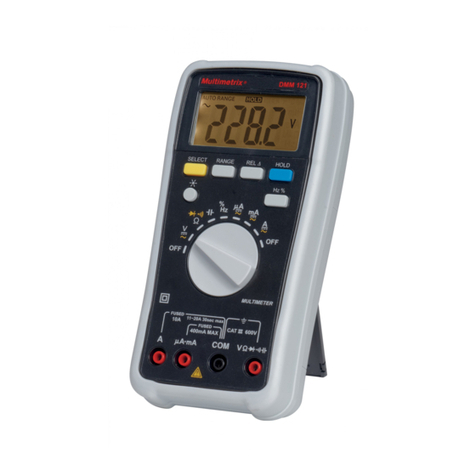
Multimetrix
Multimetrix DMM121 User manual

Multimetrix
Multimetrix DMM 107 User manual

Multimetrix
Multimetrix DMM 230 User manual
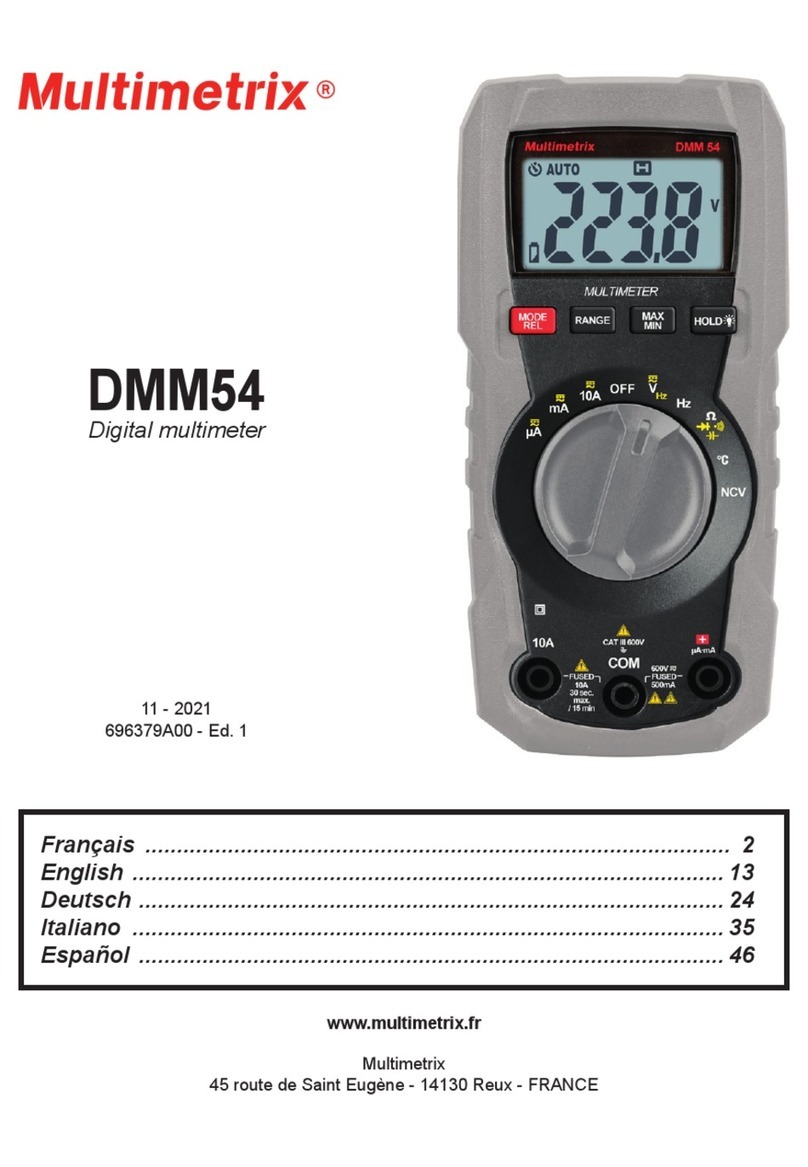
Multimetrix
Multimetrix DMM54 User manual

Multimetrix
Multimetrix DMM 13 User manual
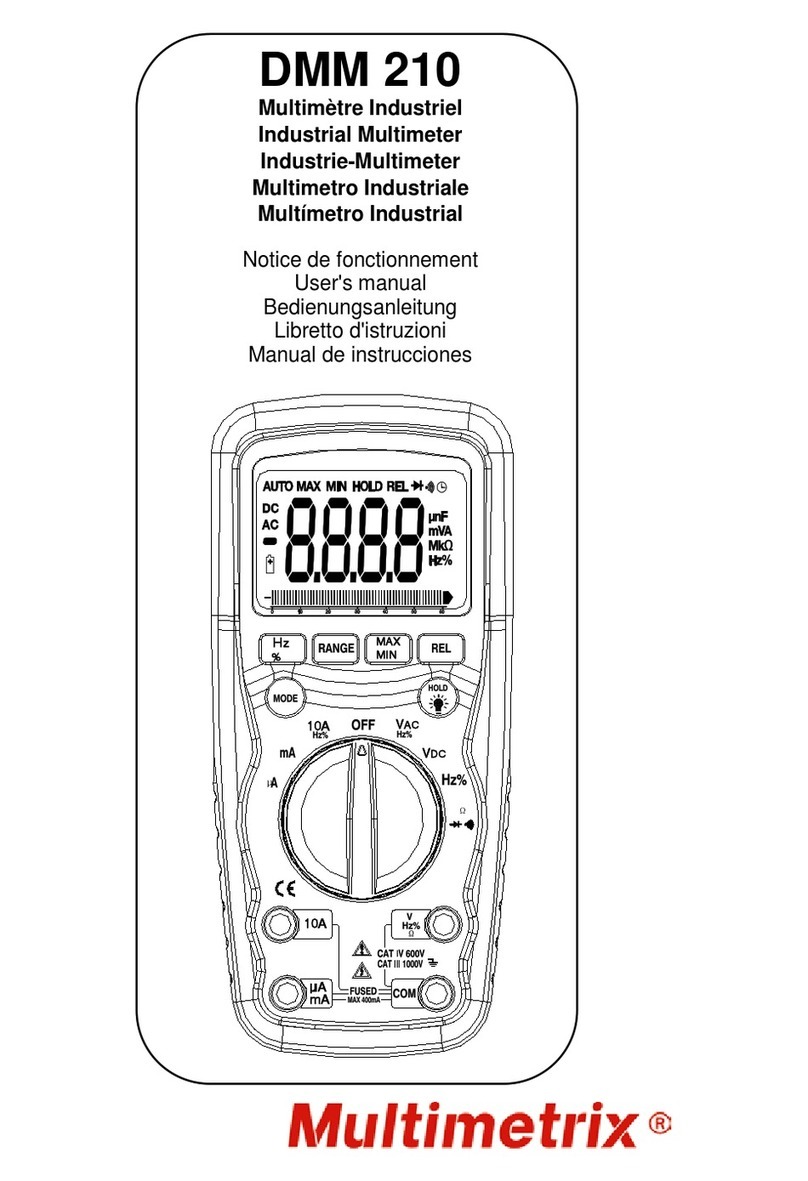
Multimetrix
Multimetrix DMM 210 User manual
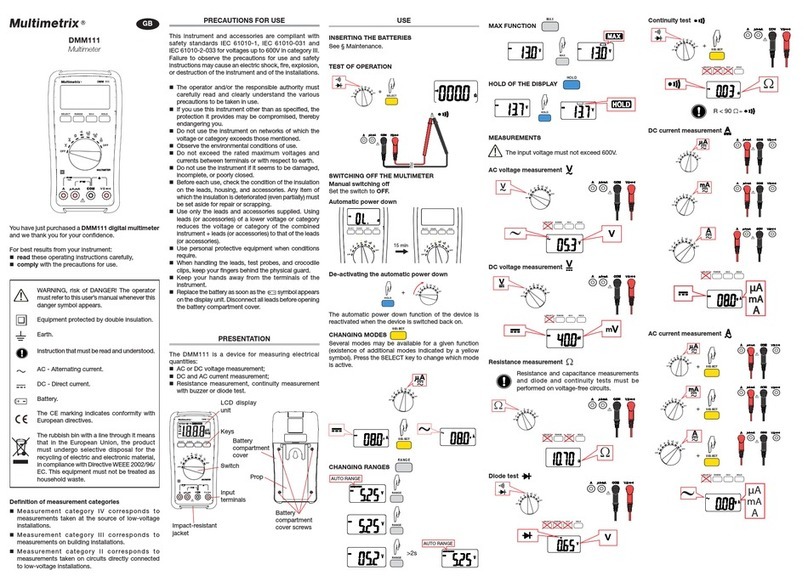
Multimetrix
Multimetrix DMM111 User manual
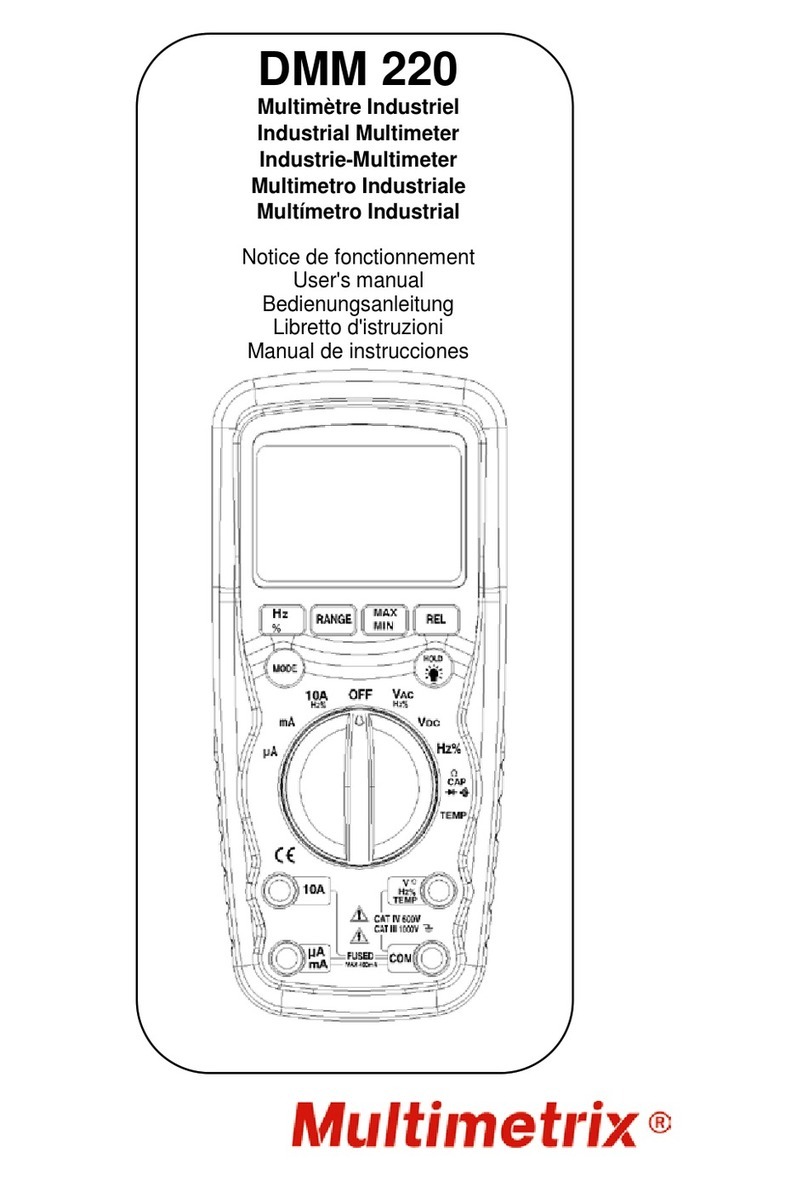
Multimetrix
Multimetrix DMM 220 User manual
